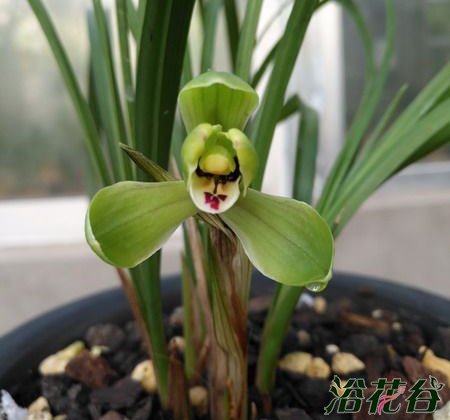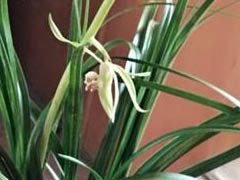What happened to the yellow leaves of orchids (12 kinds of yellow leaves)
For orchids who have just raised orchids, it is not uncommon to encounter the yellowing of orchid leaves, but many flower friends can not figure out the reasons for the yellowing of leaves. This article is a summary of 12 kinds of yellow leaves of orchids. I hope it can be helpful to orchids.

1. Lao Huang
Old age, pin bone erosion. If you have no energy, you will naturally turn yellow. Generally occurs in many generations of Hou Longmiao, bottom-up or top-to-bottom yellow, are not a big deal.
2. Yellow fetus
The response of new buds in gestation is often synchronized with new buds. Sometimes the yellow is slow, sometimes the yellow is fast, sometimes it starts from the side leaves, sometimes it is yellow and green. The end result is that new buds grow quickly and new roots do not grow, resulting in the same fate between mother and son. This is why weak seedlings with buds are prone to problems when introduced in summer.
Or new buds are growing, new roots are growing, and they are ready to stand on their own feet, support each other and tide over the difficulties.
3. Water yellow
After being drenched in the rain for a long time, the new seedlings suddenly jointed, the lower part was white and tender, and the leaf nails turned yellow. Generally will not blacken, slowly withered away, to save water.
4. Fat yellow
Generally speaking, for fat grass, the leaf beetle will be yellow first and then black. If the accumulation of fertilizer is serious, there will be mildew and blackness in the grooves of the old leaves. Or the fat is not heavy, but it can be accumulated for a long time.
5. Soft rotten yellow
Soft rot is bacterial, watery, but yellow is not obvious, because the speed is too fast, and the leaf pants are soft and rotten, but the difference is that the leaves are dehydrated and discolored.
6. Stem rot yellow
There is dry yellow on the leaf trousers. Or light yellow, should be paid attention to. Stem rot occurs from the stem, then transmits to each node of the bulb, and then reacts on the leaves, reducing dehydration and breaking at a touch. So the orchid is tired and needs to be checked frequently.
7. Yin and Yang do not regulate yellow
First, Greater Heat was exposed to the sun, and suddenly felt distressed, so she quickly moved into the room, and some even turned on the air conditioner. Bluegrass's reaction was that the new and old leaves turned yellow and serious Yang Yang sprinkled. So that it can be sent to Jianlan. So it's best to move outside in the shade and make a slow transition. There is an imbalance between yin and yang, and the stomata open and close, resulting in physiological disorders.
8. Water injury yellow
Rain at the last budding stage, or spray on the orchid leaves to cool and humidify, in fact, small water mist is easier to enter the leaf core, water accumulates in the leaf core, it is blocked by leaf grooves and cannot be blown dry, the heavy ones cause pathological soft rot, and light ones cause physiological water injury. after leaf expansion, the scar is characterized by water injury spots are often symmetrical left and right.
I think this kind of water injury has something to do with the imbalance between cold and heat.
Otherwise, if you immerse an orchid in the water for one night, the new buds will not necessarily have water spots.
9. Root rot yellow
The cause is unknown and is characterized by rapid yellowing, dehydration and wilting of the whole clump, and all the leaves below the whole plant are intact.
10. Sun yellowing
Yellow-white, or speckled, or whole leaves, sometimes appear at the tip of the leaves, hard and yellow. At first, orchids have few resources, and they feel very rare. Then they turn the book and say that it is a sign of daffodils. Xinran, in fact, it is just Yangshan grass that turns yellow and disappears after shade.
11. Small stuffy yellow
It comes from the leaves of the heart. Just one piece. Everything else is intact. They are all available in Chunghui. They can be cut and cut, and they can also be related to plant materials, water and fertilizer, and storage environment, and temperature and humidity.
Orchid bulbs are jointed, leaves and flowers grow on a circle of nodes, the central leaf is actually like the top node of cauliflower, it is okay to fold, although it does not hurt the root, but also to arouse vigilance.
12. Yihuang
Get through, excellent flowers, tender topaz, tiger spots-congratulations.
- Prev

When is the best time to water orchids? morning and evening
Today, I saw an orchid friend ask the orchid when it is best to water the orchid. This question seems relatively simple, but there are too many factors involved in detail. And to be honest, there is no best way to water the orchid. It only depends on the ways and methods of the breeders. After all, as long as the orchid grows well, the method is not important. ...
- Next

See how the veteran flower grower answers whether orchids are easy to raise _ can novice raise these two questions?
Since ancient times, scholars like orchids, even now orchids are still popular, some orchids have never raised orchids before, but do not know orchids are easy to raise? Whether the novice can feed or not, let's take a look at what the veteran flower grower says about these two questions. ...
Related
- Is the orchid suitable for indoor use? Is it good for the body?
- How to prevent the empty root of orchids?
- What to do after the crab claw orchid is withered?
- Why are the leaves of orchids always yellow? Fertilizing and watering.
- Can the root of the gentleman orchid be saved if it is rotten?
- Diagnosis and treatment of cotton-blowing beetle insects in Cymbidium
- There is a way for a gentleman's orchid to rot.
- What is the most suitable temperature and humidity for the orchid?
- How to raise a gentleman's orchid? Cultivation techniques of Cymbidium
- How to prepare the nutritive soil for the cultivation of Cymbidium

